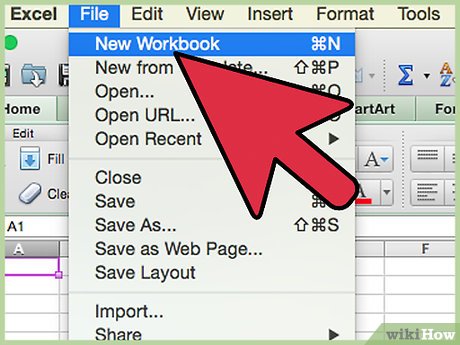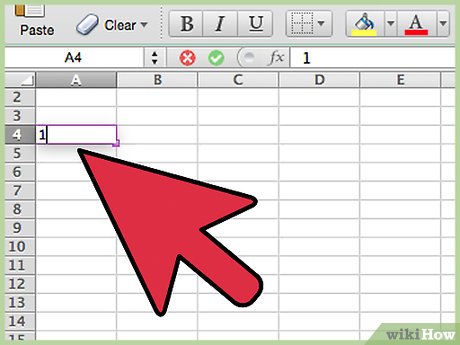How to Create a Squiggly Frame Pattern in Microsoft Excel
Part 1 of 3:
The Tutorial
-
 Start a new workbook by saving the previous workbook from Create a Floral Glassware Pattern in Microsoft Excel under a new name. Save the workbook into a logical file folder.
Start a new workbook by saving the previous workbook from Create a Floral Glassware Pattern in Microsoft Excel under a new name. Save the workbook into a logical file folder. -
 Complete all changes in the upper Defined Variables section.
Complete all changes in the upper Defined Variables section.- Enter On=0,Off=1 cell A4 = 1
- Enter Adjuster = 1
- Enter TURNS = 9
- Enter S's Count = 25
- Enter Var = 12
- Enter Divisor = 39,708,609,295
- Enter top = "=ROUND((-B4*PI())+(Adj),0)" 9679383
- Enter YN = N
- Enter Power = 2
- All the rest are the same as they were before.
-
 Complete all changes in the upper Columnar Formulas section.
Complete all changes in the upper Columnar Formulas section.- c = -24625 as the result of "=ROUND(-EXP((PI()^2)+(Cc*-(db))),0)+Designer"
- Enter to D7:D1447 w/ D7 active "=X7/Divisor+IF(COS((ROW()-7)*PI()/180*Factor)<0,ABS(COS((ROW()-7)*PI()/180*Factor))^Power*-1,COS((ROW()-7)*PI()/180*Factor)^Power)"
- Enter to E7:E1447 w/ E7 active "=Y7/Divisor+IF(SIN((ROW()-7)*PI()/180*Factor)<0,ABS(SIN((ROW()-7)*PI()/180*Factor))^Power*-1,SIN((ROW()-7)*PI()/180*Factor)^Power)"
- The External Ring and GMLL x,y and GMSL x,y formulas are unchanged. All other formulas and lookup tables are unchanged.
- Check that F7:F1447 with F7 active contains "=IF(A7=0,F6,((PI())*((SIN(B7/(C7*2))*GMLL*COS(B7)*GMLL*(COS(B7/(C7*2)))*GMLL)+D7)))"'
- Check that G7:G1447 with G7 active contains "=IF(A7=0,G6,((PI())*((SIN(B7/(C7*2))*GMLL*SIN(B7)*GMLL*(COS(B7/(C7*2)))*GMLL)+E7)))"
- Check that Sync1 refers to H2 and Sync2 refers to J2. Check the H2 formula, "=H1/GMLL" and check the J2 formula, "=J1/GMSL".
- Check the H7 formula, "=F7*GMLL*Sync1" and the I7 formula, "=G7*GMLL*Sync1".
- Check the J7 formula, "=F7*GMSL*Sync2" and the K7 formula, "=G7*GMSL*Sync2".
- Check that the lookup tables are unchanged.
Part 2 of 3:
Explanatory Charts, Diagrams, Photos
- (dependent upon the tutorial data above)
-
 Create the Chart.
Create the Chart.- Edit Go To cell range F7:G1446 on the Data worksheet and using Chart Wizard or the Ribbon, select Charts All/Other, Scatter, Smoothed Line Scatter. Copy the Chart to the Chart worksheet and expand it with the double-headed arrow via the bottom right corner.
- Select Chart Layout and get rid of the axes and grid lines and legend; select Data Series 1 and make Line Weight 1 color Deep Purple from the Color Wheel.
- Create the second chart with Plot Area background Black Fill. and paste in the GMLL and GMSL series and edit the series if they've arrived wrong until they read in the formula bar as follows:
- =SERIES(,DATA!$H$7:$H$1446,DATA!$I$7:$I$1446,1) Burgundy Red
- =SERIES(,DATA!$J$7:$J$1446,DATA!$K$7:$K$1446,2) Turquoise (Blue)Green
- =SERIES(,DATA!$F$7:$F$1446,DATA!$G$7:$G$1446,3) Blue Purple
-
 Copy the live formulas and Paste Special Values then too to Saves, then Do Copy Picture and Paste Picture from the Chart with the Shift Key depressed to Saves and Save the workbook. Do so for each modification in the Tips section below.
Copy the live formulas and Paste Special Values then too to Saves, then Do Copy Picture and Paste Picture from the Chart with the Shift Key depressed to Saves and Save the workbook. Do so for each modification in the Tips section below. -
 Squiggly Eye at Alpine
Squiggly Eye at Alpine
Part 3 of 3:
Helpful Guidance
- Make use of helper articles when proceeding through this tutorial:
- See the article How to Create a Spirallic Spin Particle Path or Necklace Form or Spherical Border for a list of articles related to Excel, Geometric and/or Trigonometric Art, Charting/Diagramming and Algebraic Formulation.
- For more art charts and graphs, you might also want to click on Category:Microsoft Excel Imagery, Category:Mathematics, Category:Spreadsheets or Category:Graphics to view many Excel worksheets and charts where Trigonometry, Geometry and Calculus have been turned into Art, or simply click on the category as appears in the upper right white portion of this page, or at the bottom left of the page.
4.5 ★ | 2 Vote
You should read it
- 7 How to increase the size of the ring 1 for her chest
- ROUND function in SQL Server
- The round () function in Python
- What is a worksheet? Differentiate between Worksheet and Workbook
- Round a number in Excel (ROUND function)
- MS Excel 2007 - Lesson 3: Working with Workbook
- Round function, how to use rounded functions in Excel
- How to create the first Workbook in Excel
May be interested
- How to Create a Line of Spheres Pattern in Microsoft Excel
 you'll learn to make the 'line of spheres' pattern and image below, and the dozens of variations the file permits therefrom. become familiar with the basic image to be created:
you'll learn to make the 'line of spheres' pattern and image below, and the dozens of variations the file permits therefrom. become familiar with the basic image to be created: - How to Create a Skewed Spheroids Pattern in Microsoft Excel
 in this article, you'll learn to make the 'skewed spheroids' pattern like the image below, and the dozens of variations the file permits therefrom. this article relies on the previous accomplishment of the five articles preceding it:
in this article, you'll learn to make the 'skewed spheroids' pattern like the image below, and the dozens of variations the file permits therefrom. this article relies on the previous accomplishment of the five articles preceding it: - How to create a pie chart in Microsoft Excel
 pie charts are a great tool for visualizing information. it allows users to see the partial relationship with the entire data.
pie charts are a great tool for visualizing information. it allows users to see the partial relationship with the entire data. - How to Create a Chart in Excel
 in this article, tipsmake will show you how to create visual data visualizations in microsoft excel using pie charts. open the microsoft excel program.
in this article, tipsmake will show you how to create visual data visualizations in microsoft excel using pie charts. open the microsoft excel program. - How to Reset Lock Pattern on Android Tablet
 today's tipsmake will show you how to create or change the home screen unlock pattern of your android tablet. you can also access your tablet if you forget your unlock pattern. if you use a version released after android 4.4 (kitkat), the only way to restore the unlock pattern (if you forget it) is to erase all data on the tablet and reinstall it from scratch.
today's tipsmake will show you how to create or change the home screen unlock pattern of your android tablet. you can also access your tablet if you forget your unlock pattern. if you use a version released after android 4.4 (kitkat), the only way to restore the unlock pattern (if you forget it) is to erase all data on the tablet and reinstall it from scratch. - How to Create a Tekeporter Frame Image in Excel
 ever wondered what it would be like to teleport through wormholes across the universe? here's one idea - the 'tekeporter'. or, you can use it as a nice frame for your cosmic poetry/stories/invitations ... whatever! the idea is that each...
ever wondered what it would be like to teleport through wormholes across the universe? here's one idea - the 'tekeporter'. or, you can use it as a nice frame for your cosmic poetry/stories/invitations ... whatever! the idea is that each... - Complete tutorial of Excel 2016 (Part 3): How to create and open existing spreadsheets
 today, we continue to share with you how to create and open spreadsheets available in excel 2016.
today, we continue to share with you how to create and open spreadsheets available in excel 2016. - How to use Excel Online online for free
 excel online is located in the completely free microsoft office online suite with full features, from the ability to create spreadsheets, use calculation functions, ...
excel online is located in the completely free microsoft office online suite with full features, from the ability to create spreadsheets, use calculation functions, ... - Link download Microsoft Excel 2019
 microsoft excel is a software program created by microsoft that allows users to organize, format and calculate data with formulas using a spreadsheet system.
microsoft excel is a software program created by microsoft that allows users to organize, format and calculate data with formulas using a spreadsheet system. - A complete guide to Excel 2016 (Part 4): How to store and share spreadsheets
 whenever you create a new spreadsheet in excel, you need to know how to save to access and edit later. like previous versions of excel, you can save local files to your computer.
whenever you create a new spreadsheet in excel, you need to know how to save to access and edit later. like previous versions of excel, you can save local files to your computer.













 How to Acquire Bézier Curves Using Excel
How to Acquire Bézier Curves Using Excel How to Work with Excel Cubes
How to Work with Excel Cubes How to Create Artistic Patterns in Microsoft Excel
How to Create Artistic Patterns in Microsoft Excel How to Create a Uniform Spiral Pattern in Microsoft Excel
How to Create a Uniform Spiral Pattern in Microsoft Excel How to Create a Sin and Cos Circle in Excel
How to Create a Sin and Cos Circle in Excel How to Create a Curve in Excel
How to Create a Curve in Excel